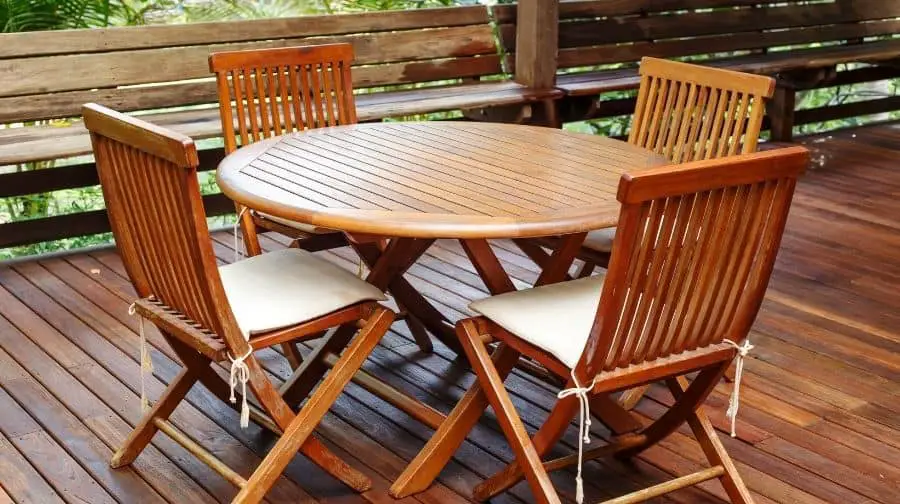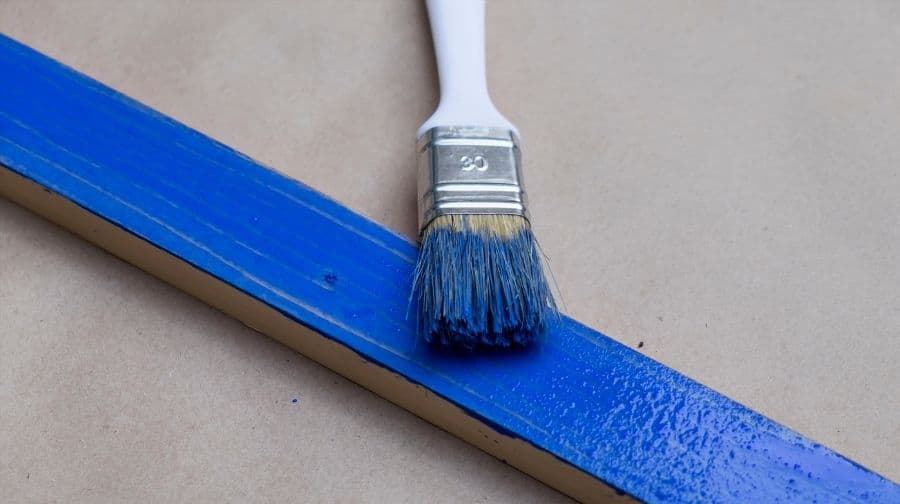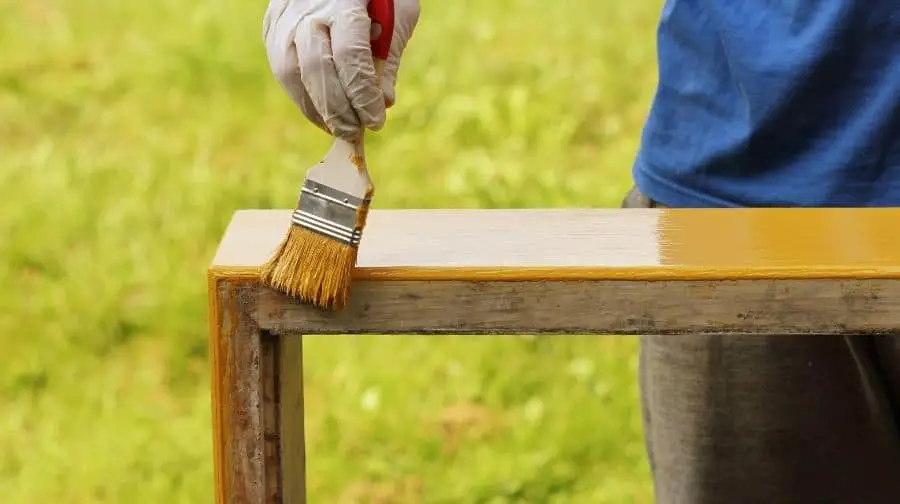
When it comes to choosing the right material for your project, you have a lot of options. One of the most common decisions is whether to use wood stain or paint. Both products have their own unique benefits and drawbacks, so it can be tough to decide which one is right for you.
In this blog post, we will compare wood stain vs. paint and help you decide which option is best for your needs!
Wood Stain vs. Paint
The major difference between wood stain and paint any woodworker should know is their applications on the wood. Stain penetrates deep into the wood’s pores. On the other hand, paint just coats the top of the wood. It means, in the case of paint, it would be a layer of pigments on the wood. On the other hand, stain pigments penetrate deep into the wood pores while giving the real color.
Furthermore, another significant difference in their results for the wood. While applying stain, it gives, protects, and preserves the beauty of the wood while paint only covers and hides it. These are some major differences on which all the other distinctions are based. Let’s go through each difference in detail to make it further clear, so you can decide to either stain or paint the woods.
| Category | Stain | Paint |
| Cost | Around $20 to $30 per gallon. | Start at $30 and range up to $60 per gallon. |
| Naturality | Fills the wood pores with its pigment leaving the natural grain pattern. | Makes a thin layer of rich pigments, hiding the original look of wood. |
| Variety | Fewer varieties available but still many options. | More options available. |
| Application | Sanding, pre-stain, then stain. | Sanding, preservatives, primer, then paint. |
| Durability | Heat related discoloration | Chipping and peeling (lasts longer) |
| Difficulty | Less steps. | More steps. |
| Maintenance | Less maintenance. | More maintenance. |
#1 Cost
Stain costs around $20 to $30 per gallon, while paint costs start at $30 and range up to $60, making it almost double the stain cost. Further wood preservatives are required for painting, which costs $5 to $20 per gallon. On the other hand, the stain doesn’t require preservatives. That’s why the stain is comparatively cheaper.
#2 Naturality
The stain gives a natural look to the wood by just filling the wood pores with its pigment. As a result, the wood actually shows its grain pattern, making it look more attractive and elegant. On the contrary, paint makes a thin layer of rich pigments, hiding the original look of wood. That’s why paint looks more fake than stain and affects the original quality and look of wood.
#3 Variety
Since stain is designed to give or enhance the original look of any wood, it’s available in a few varieties. At the same time, paint is available in a huge variety, having lighter to darker colors to give any desired look you want.
#4 Application
The staining process involves sanding the wood surface first. Then make it even further smooth to get ready for the stain to apply right away. After cleaning the dust, the stain is applied, and let the wood dry naturally. You may need another coat in some cases but not all.
Conversely, you have to apply preservatives and then coat them with a quality primer. It costs more money, takes more effort and time. Later, two coats are the minimum requirements to get the desired finish. Last, the painted surface is sealed with a clear PU sealer to let it last longer.
So, we can conclude that paint requires more steps, time, and effort to get the desired look of the wood. It comes with a lot more additional cost, making the process quite expensive. However, you get a variety of colors, which a stain fails to provide. Still, the stain is worth the shot to get a natural look at a lower cost.
#5 Durability
The stain is often prone to heat-related discoloration, and paint has unique problems like chipping and peeling. But when it comes to overall long-lasting, paint lasts comparatively longer than the stain. The main reason is that paint covers the wood with its pigment layer while having another PU sealer that keeps it intact for a longer period. The stain only protects the wood against moisture, while paint protects against UV radiation and other external factors, which also keep the wood protected.
#6 Difficulty
You don’t have to be an expert in woodworking to stain the wood. On the other hand, you may go through more steps than staining to get the same finish. An extra step in painting includes applying preservatives and quality primes. In the case of a stain, these two steps are not necessary, making it easier than paint. Last, you may not need a double coat while staining but definitely need it for painting.
#7 Maintenance
You have to maintain the wood in both cases, either when painted or stained. However, maintenance is less during staining and more for painted wood. For instance, you may need to remove mold and bacteria once a year. Also, apply cleaner by roller or sprayer while scrubbing down the dingy spots.
Paint Vs. Stain
Subscribe to Fix.com on Youtube
Whether you’re looking to give an old deck a face lift or take a new deck to the next level, there will come a time when you must answer the age-old question……..Paint or Stain?!
In this video, Natalie will take you through some of the pros and cons of painting and staining your deck, so you can determine what’s right for you!
Wood Stain vs. Paint on Furniture
| Stain | Paint |
| Less variety of colors | Wide variety of colors |
| Natural Look | Full color look |
When it comes to Wood stain vs Paint on furniture both look brilliant on furniture; however, they may vary a lot in the finish. Paint offers a wide range of variety, but the stain has restricted colors. Since the stain provides a natural look, its colors do not vary too much from the original look.
Another significant difference to notice for furniture is covering the furniture’s flaws. If it’s mild, sanding and applying the stain can make it look new. But you may require painting single or double layers to cover the severe issues to make the piece look new again.

Wood Stain vs. Paint for Fence
When it comes to wood stain vs paint for fences, the stain is often preferred. The stain doesn’t peel, blister, or crack like paint. Also, it can be a great choice to give the fence a natural color. However, if you want to entirely transform the fence into a different color, paint can be a great choice.
Still, the stain is better in terms of application ease, cost, and offering a natural look. Since the fence has to be outside, you should consider durability and protection factors too. In that case, the paint lasts longer and offers comparatively more protection against UV radiation.
Stained Cabinets vs. Painted Cabinets
Subscribe to Classic Kitchens, Etc. on Youtube
Wood Stain vs. Paint On A Door
There are a few things to keep in mind when deciding between wood stain vs paint for your door. The first is the overall look you’re going for. If you want a more natural look, then wood stain is the way to go. Paint can give your door a more finished look, but it will also cover up any of the natural grain of the wood.
Another thing to consider is how much maintenance you’re willing to do. Paint will need to be touched up every few years, while stain can last for several years before it needs to be reapplied. Stain is also easier to apply than paint, so if you’re not the most handy person, that might be something to keep in mind.
So, what’s the verdict? It really depends on your personal preference and what you’re looking for in a door. If you want something that’s low-maintenance and has a more natural look, then wood stain is the way to go. But if you’re willing to do a little bit of work every few years, and you want a door with a more finished look, then paint is the better option.
Paint vs. Stain Experiment
Subscribe to ehowhome on Youtube
It’s come time for Allen to choose the final look for the back porch, and he’s torn between a painted railing or a stained railing. Watch, as he decides what to do!
What Lasts Longer Stain Or Paint?
Generally, paint lasts much longer than stain due to its thin layer on the wood, which protects the wood and itself against external weather conditions, such as rain, storm, UV radiations, and moisture. Its thin layer perfectly covers the wood while leaving no cracks or holes.
Also, the paint ends up sealing and primed, which makes it last for 10 years if premium quality paint is used. And when you paint multiple coats, the longevity increases. Usually, a single coat can easily last for around 2 years, and if you want to make it 10 years or more, a double coat is necessary.
Is It Easier To Paint Or Stain Wood?
It is generally easier to stain wood than to paint it. Paint can be difficult to apply evenly, while stain is much simpler to apply. Also paint often requires multiple coats in order to achieve the desired color, while stain only needs one or two coats. In short, painting wood can be time consuming and difficult, while staining it is generally much easier.
However, you require precise sanding and then wiping the debris off the wood to get the process of staining started. This process is the same during painting. When finished the paint doesn’t look natural, gets cracked and peeled, which is not the case with the stain.

What Is The Difference Between Wood Stain And Wood Paint?
Wood stain basically contains color pigments that penetrate deep into the wood while giving a natural look besides enhancing the original look and color. When it comes to wood paint, it provides a colorful protective layer while covering all the holes and cracks to give an entirely new look to the wood.
Another difference between these two products is that stain will protect your wood from weathering, while paint will not. This is because the stain penetrates deep into the wood, creating a barrier against moisture and sunlight.
Also the cost of wood stain is cheaper than the cost of paint.
If you want to show off the natural beauty of your wood, go with a stain. If you want to change the color of your wood or protect it from the elements, go with a paint.
Is It Better to Stain or Paint a Barn?
it’s better to paint because the barn is exposed to direct sunlight, excessive heavy rains, and snow, which may cause damage to the walls. You have two options — a brand new look or an original aged look. For a brand-new look, you may need to paint it, but staining is necessary to give an aged look. So, whatever you prefer can be helpful.
In that case, paint helps to protect and lasts longer during challenging weather conditions. If you can’t afford the cost of painting, go for staining instead at a lower cost. Also, you can make it easier to stain the barn as it doesn’t require sealing, preservative, and primer.
Can You Paint Over Stain?
Yes, you can paint over stain. In fact, painting over stain is a great way to give new life to old furniture. The key to success is in the prep work. You’ll need to sand the piece of furniture down and then apply a primer before painting. With a little bit of elbow grease, you can transform an old piece of furniture into something new and fresh.
Can You Paint Over Stained Wood Without Sanding?
Yes, you can paint over stained wood even without sanding, but it may require an oil-based primer to seal the wood.
However, stained wood should be sanded first, so the paint has a nice surface that welcomes the paint to stick better and last longer. This can also avoid instant cracks and peeling off. Still, if you don’t want to sand first, you can go for it.
Does Stain Protect Wood?
No, stain does not protect wood. A sealer provides the first line of defense against water damage, decay, and UV rays. After that, stain adds beauty while still allowing the wood to breathe. If you have an older deck, staining it can revive its appearance and give it new life.
Stain comes in a variety of colors and opacity levels. You can choose from clear to solid, and there are even some semi-transparent options. The level of opacity will determine how much of the wood’s grain is visible.
When shopping for stain, always check the labels carefully. Some products advertised as “stain” are actually sealers that don’t provide any color. Others may be pigmented stains that don’t penetrate the wood’s surface, sitting on top like paint. Neither of these products will do a good job of protecting your deck.
The basic purpose of staining wood is to get the natural color and not protect it. However, it does manage to protect against moisture. But it fails when protecting against UV radiations, heavy rain, and more external factors. Still, it protects at some level but not as much as paint. For premium protection, paint is often used and proven helpful. Besides, paint also gives a brand-new look to the wood.
Furthermore, you can go through the sealing process and use the primer to adhere the stain better on the wood. Still, it’s not enough to get more protection than paint. We can conclude that stain offers moisture protection, and some insects that affect wood are also restricted with stain.

Is Wood Stain Better than Varnish?
Wood stain is better than varnish for bringing out the natural grain of the wood. Varnish can actually obscure the grain and give the wood a plastic-like appearance. Wood stain penetrates into the wood, while varnish forms a film on top of the wood. This means that over time, varnish will start to crack and peel, while stain will simply fade. If you want your wood to age gracefully, stain is the way to go.
That said, varnish does have its advantages. It’s much more durable than stain and it’s easier to apply. If you’re looking for a low-maintenance finish, varnish is probably your best bet.
Varnish acts similar to paint and is often used to protect the surface besides giving a brand-new look. So, in terms of safety, it’s better than wood stain. Otherwise, it doesn’t give a natural look like wood stain and costs more money as well.
When it comes to durability, varnish lasts for 2 years, which is longer than stain but less than paint. Also, it offers comparatively less protection than paint but a lot more than wood stain. So, we can conclude that it’s a better choice than stain but not paint.
Is Wood Stain The Same As Paint?
No, wood stain is not the same as paint. Stain is made up of a pigment and oil, while paint is made up of a pigment and latex. Stain penetrates the wood grain, while paint forms a film on the surface of the wood. When applied correctly, stain will enhance the natural beauty of the wood grain, while paint will give the wood a uniform color.
There are a few things you should keep in mind when choosing a stain or paint for your project. First, decide if you want a translucent or opaque finish. Translucent stains will allow the wood grain to show through, while opaque stains will give the wood a solid color. Second, consider the amount of time and effort you are willing to put into maintaining the finish. Stain requires less maintenance than paint, but it will need to be reapplied more often. Paint is more durable and will last longer, but it will require more work to keep it looking its best.
If you are looking for a low-maintenance option, stain is the way to go. If you want a long-lasting finish, paint is the better choice. Ultimately, the decision comes down to personal preference. Experiment with both options to see which one you like best.
Paint Vs Stain On Cabinets
Here are a few things to keep in mind when considering Paint Vs Stain on Cabinets.
Painted cabinets are very versatile. You can pretty much paint them any color you want, so if you’re looking for a specific color scheme, they’re a good option.
They also tend to show less wear and tear than stained cabinets since the paint protects the wood better.
Stained cabinets have a more natural look. If you’re going for a rustic or country kitchen, stained cabinets are a good option.
They can also be easier to touch up since you’re just dealing with the stain and not paint.



